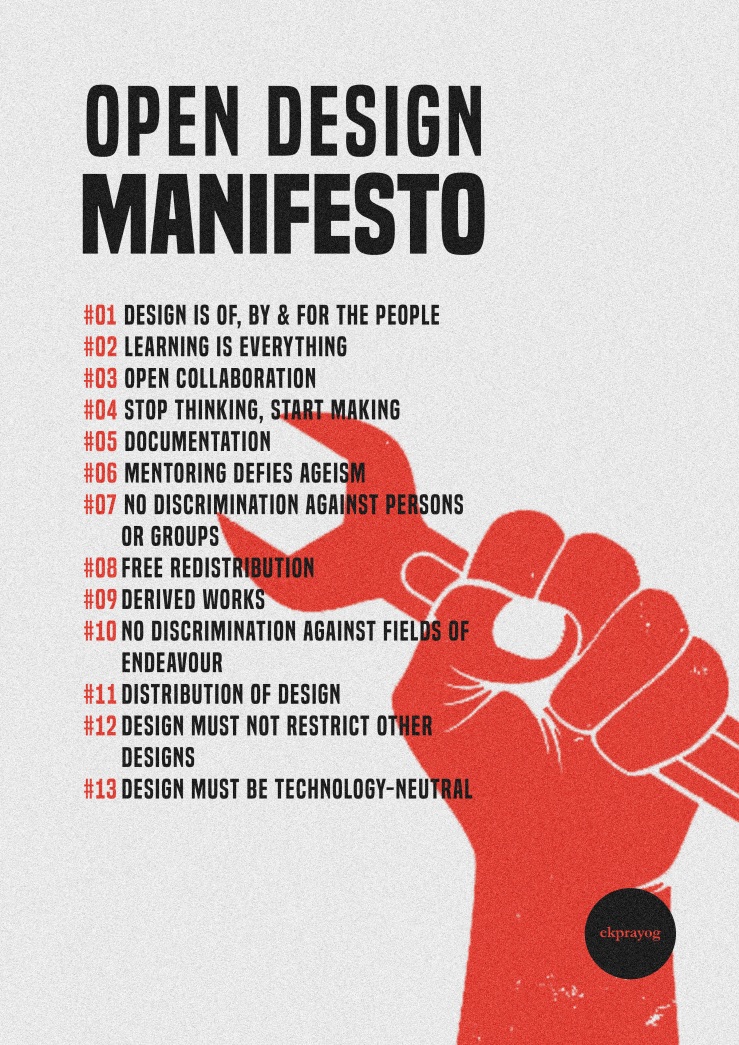A manifesto is a published verbal declaration of the intentions, motives, or views of the issuer, be it an individual, group, political party or government. A manifesto usually accepts a previously published opinion or public consensus or promotes a new idea with prescriptive notions for carrying out changes the author believes should be made. It often is political or artistic in nature, but may present an individual’s life stance.
– Wikipedia
Open Design Manifesto is something which I believe and have been practicing for past 2 years. It lists down some mindsets, attitudes, intentions which are necessary if one wants to practice open design.
Poster/Card format. PDF download Link Open Design Manifesto
Open Design Manifesto Poster condensed.

A bit on Open Source Movement
Open Source refers to the model of providing goods and services which includes the possibility of the end-user’s participation in the production of these goods and services. Open participation and collaboration – which implies the vulnerability to share work in progress, without ego, power struggle, and insecurity. The core values are efficiency, and the ethics and wisdom to understand what we should be efficient about. In practice, we should strive to find effective ways to document our work – to create an open collaboration platform – where collaborators can come on boards rapidly. While it is difficult to document – the real-time, online collaborative tools (like Instructables) of the information age make it easier – and we should aim to tap these new tools to document and develop together.
This concept has already been demonstrated in open source software and hardware. The crossover between software and hardware has lead to Open Design.
Open design is the development of physical products, processes and systems through use of publicly shared design information. Open design process is generally facilitated by the Internet. The goals and philosophy is to lead to the development of physical products rather than just software. Open design is a form of co-creation, where the final product is designed by the users, rather than an external stakeholder such as a private company.
Open source movement has lead to opening access to the information and technology which enables a different economic system to be realized, one based on the integration
of natural ecology, social ecology, and industrial ecology. This economic system is based on open access- based on widely accessible information and associated access to productive capital- distributed into the hands of an increased number of people. Companies like Local Motors, Esty are practicing this.
A highly distributed, increasingly participatory model of production is the core of a democratic society, where stability is established naturally by the balance of human activity with sustainable extraction of natural resources. This is the opposite of the current mainstream of centralized economies, which have a structurally built-in tendency towards of overproduction.
The integration of the natural, societal, and industrial ecologies – Open Source Ecology- aims at sustainable and regenerative economics. We are convinced that a possibility of a quality life exists, where human needs are guaranteed to the world’s entire population- as long as we ask ourselves basic questions on what societal structures and productive activities are truly appropriate to meeting human needs for all.
At the end of the day, the goal is to liberate our time to engage in exactly that which each of us wants to be doing- instead of what we need to do to survive. All have the potential to thrive.
Today, an increasingly smaller percentage of the world’s population is in this position.


[…] After convocating I’ve been thinking of doing some small workshop on getting people introduced to ideas of my thesis “Design Democracy and Tinkering”. So, I sent a workshop brief to Praveen and he was kind enough to let me take a module with the 7th semester Product Design students. The basic idea of this module “Making for the Real World” was to get them introduced to concepts like open source, digital fabrication, redistributed manufacturing, technology, DIY & maker culture, sustainability and the most important thing of documentation of work and publication. I also made a manifesto on the same principles and can be read on this link. […]
LikeLike